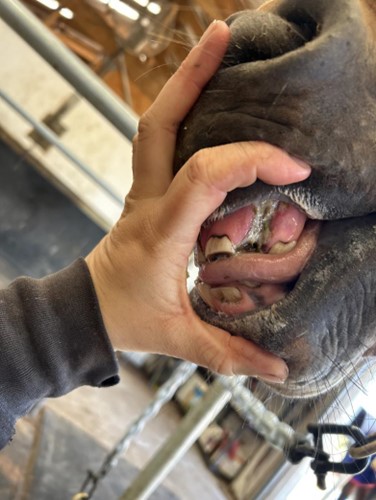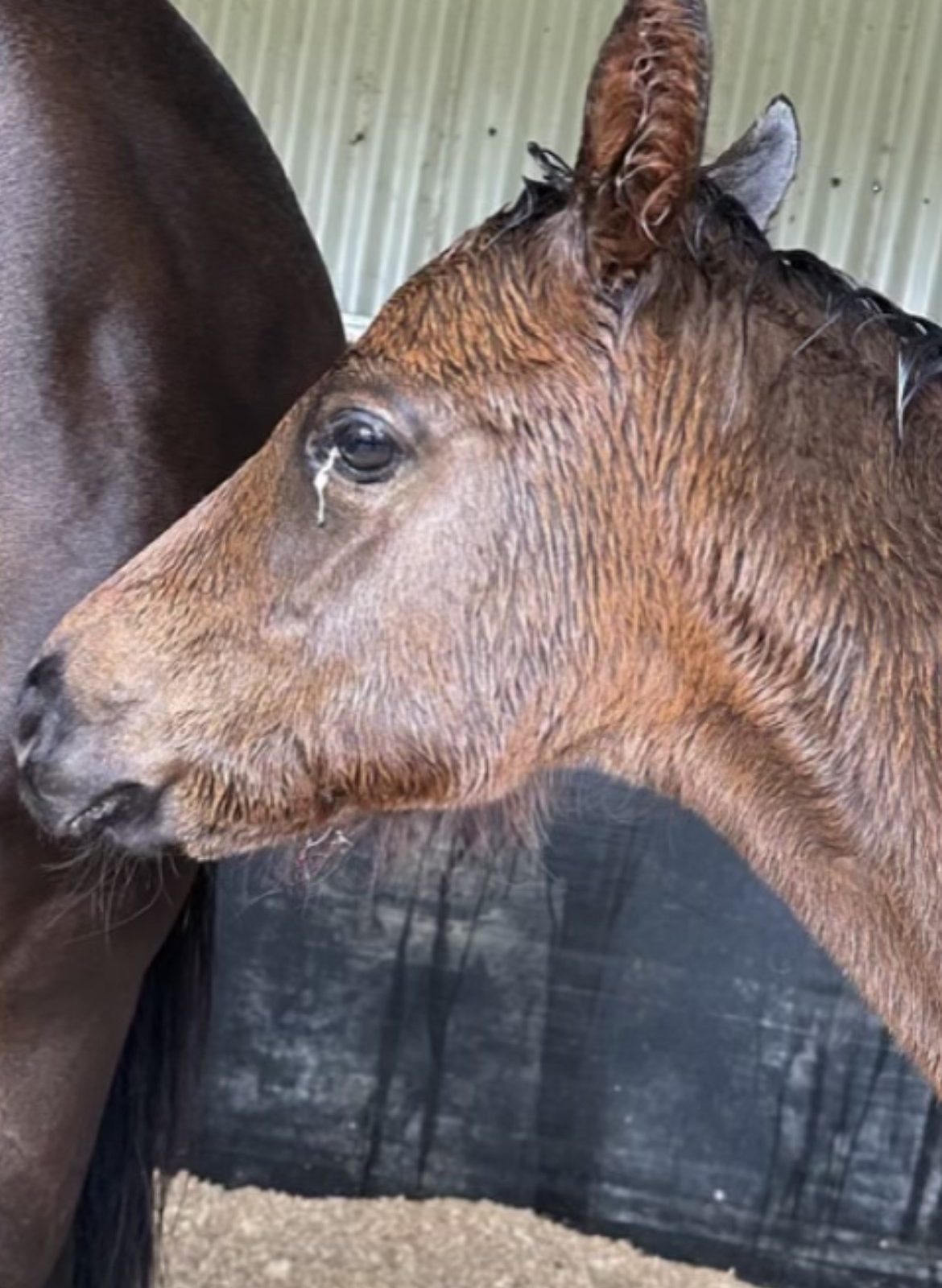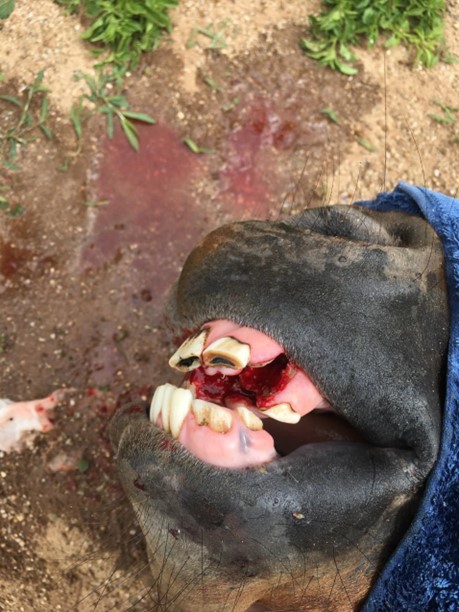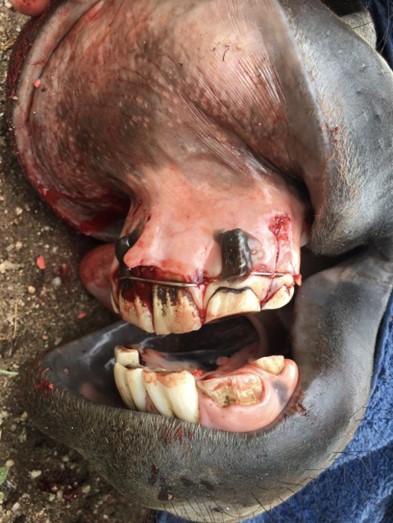Horses can injure themselves in many places and in many ways. Often it is their legs that end up injured from kicking something or being kicked themselves, but wounds to the head can occur commonly. Many head injuries occur through misadventure and not from work; fractured jaws, the topic of this article, are good examples.
There are many ways a horse can fracture a jaw but by far the most common, in my experience, is from getting its teeth hooked on something and then pulling back and fracturing the front part of either the upper or lower jaw. Young colts are particularly prone to these types of fractures as they love biting and nipping objects when they play or are bored. They latch onto an object, getting their incisor teeth firmly attached and then are either startled and pull back, snapping the jaw, or they get their teeth stuck and pull back trying to free themselves.
Mesh wire and chains are common sources as it is easy for the teeth to become caught in the wire or links of chain, and when the horse pulls back, the loops become anchored on the teeth. The weakest point then becomes the bone, which is fractured and displaced, allowing the teeth to be freed from wire.

Trauma is the other common cause of jaw fractures and can be associated with kicks to the head region, running into objects, or having solid objects impact on the jaw region. This can happen with horses falling, being hit by vehicles or malicious intention (thankfully I haven’t had to deal with someone hitting the horse over the face with a piece of wood, but it has happened). Trauma to the side of the head towards the back, below and behind the eye region can fracture the temporal mandibular joint (TMJ) or the joint between the upper and lower jaw. This joint allows the horse to open and close its mouth and when fractured causes many difficulties for the horse.
Some injuries acquired from traumatic incidences cause open wounds and the fractured bone is exposed. These injuries require the exposed bone to be cleaned and debrided to reduce the risk of bone infection. Sequestrums can also form following trauma to the jawbone, requiring surgical intervention further down the line, even if the original fracture heals conservatively.
Horses that have had an infection in the jawbone or a tumor are at risk of developing pathological fractures in their jaw, but these are rare.
Many fractures are obvious and can be identified readily when the owner sees the horse. Sometimes the signs are less obvious, and the owner will only notice the horse drooling saliva/blood or unable to eat its food. Fractures involving the teeth can often present with foul smelling breath as food becomes lodged in the damaged area and the bacteria in the mouth rapidly invade the area producing that necrotic smell. Fractures that have been present for long periods can be associated with muscle wastage of the large masseter muscle that sits over the lower jaw, particularly if the nerve to the muscle is damaged or the TMJ joint is involved.

Fractures can often be diagnosed without X-rays, especially when the bone has been fractured rostrally (toward the nose) and the bone is displaced so the teeth can be seen pointing in a different direction to normal. Differentiation by the vet may be required in some cases, however, to ensure that it is the bone and not the teeth that have been fractured. X-rays are required to diagnose fractures involving the back part of the jaw and to assess whether bone fragments are present that may need removing. They are also required when there is a lot of swelling around the face without displacement of teeth to highlight a fracture.
Sometimes fractures go unnoticed and heal incorrectly, causing a malalignment of the teeth, or compromise the TMJ. For these horses the symptoms can be quite variable and may relate to problems associated with a bit in the horse’s mouth such as head shaking, bit resentment and poor behaviour. These horses require a more thorough work-up to identify the old fracture and can need CT scans if X-rays aren’t definitive. Particularly around the TMJ where there is a lot of overlap with the joint and bones on the opposite side of the skull, CT scans are superior to the X-rays at diagnosing fractures and associated pathology.
“Sometimes fractures
go unnoticed and
heal incorrectly.”


Treatment for a fractured jaw can vary from conservative treatment to wire placement, and in more complicated fractures, plates and screws. The type of treatment required will depend on the location of the fracture and whether there is displacement of the fragment. Fractures on one side of the mandible (lower jaw) or maxilla (upper jaw) can be left to heal without any surgical intervention if there is no displacement of the bone. As the jaw has the two sides (left and right), a non-displaced fracture on one side can heal with conservative treatment as the other side can act like a stabiliser and prevent movement on the fractured side. Fractures on the caudal, or back part of the jaw, may require surgery and the placement of a plate, especially where the fractured bone is displaced (two bones aren’t aligned correctly).
“The type of treatment
required will depend on
the location of the fracture.”
When the teeth are involved with the fracture, they should be given every opportunity to be salvaged and not automatically removed as many teeth will remain viable if they are repositioned back into their socket due to the great blood supply that supports the mouth. Teeth that are badly fractured or have completely been forced from the mouth by the trauma should be disposed of. Deciduous teeth are of less concern but permanent teeth play an important role in maintaining a healthy bite in the horse. If after several weeks the involved teeth are loose and show evidence of infection, they can be removed.
Commonly seen fractures on the rostral part of the mandible and the upper maxilla can be fixed using wire to hold the bone and/or teeth in place. There are several ways the wire can be placed, and this depends on the site and severity of the fracture. In simple cases the wire can be applied around the teeth to stabilise the fracture and anchored so that the two fractured sides of the bone stay aligned. Sometimes the surgeon needs to drill a small hole through the jawbone so the wire can be anchored using both the teeth and the jawbone to maintain good alignment and stability. These wires are kept in for approximately 6-8 weeks and are then removed simply by cutting the wire and pulling it out.


To prevent the end of the wires from cutting the mouth, a product call methyl methacrylate is commonly applied to the joins in the wire to form a smooth coating that prevents ulceration in the mouth and reduces the impact on the horse’s ability to chew or eat. Most horses can eat normally soon after the surgery is performed and only require the mouth to be cleaned regularly with a hose to remove any food that may get caught on the wire. Post-operatively, horses are generally prescribed with a short course of antibiotics and anti-inflammatory medications to reduce any discomfort they may feel.

If plates and screws are required, the surgery must be performed as sterilely as possible because of the risk of infection. If the plate or screws become infected there is an increased risk of the bone becoming infected and this will then prevent the fracture from healing. Infected plates or screws must be removed and cannot be left in the horse’s jaw, however, surgery to remove these can be delayed and long-term antibiotics administered to allow more time for the fracture to stabilise before the hardware is removed.
Prognosis for most fractured jaws is excellent provided they are managed well from the beginning. EQ
“Prognosis for
most fractured
jaws is excellent…”
YOU MIGHT ALSO LIKE TO READ BY DR MAXINE BRAIN:
Keeping Our Country Free of Disease – Equestrian Life, November 2023
Managing Endometritis – Equestrian Life, October 2023
Granulosa Cell Tumours – Equestrian Life, September 2023
Being a Horse in Africa – Equestrian Life, August 2023
Splint Bone Fractures – Equestrian Life, July 2023
When Horses Choke – Equestrian Life, June 2023
The Challenge of Treating HPSD – Equestrian Life, May 2023
From the Horse’s Mouth: Salivary Glands – Equestrian Life, February 2023
Cardiac Murmurs – Equestrian Life, February 2023
Matters of the Heart – Equestrian Life, January 2023
Umbilical Concerns in Foals – Equestrian Life, December 2022
Retained Foetal Membranes – Equestrian Life, October 2022
Preparing for Laminitis – Equestrian Life, September 2022
Working Together for Best Outcomes – Equestrian Life, August 2022
What Constitutes an Emergency – Equestrian Life, July 2022
Peri-Tarsal Cellulitis Calls for Quick Action – Equestrian Life, June 2022
Sinusitis: Not To Be Sneezed At – Equestrian Life, May 2022
Japanese Encephalitis: No Cause For Alarm – Equestrian Life, April 2022
Hernia Learning Curve – Equestrian Life, March 2022
Osteochondromas: Benign But Irritating – Equestrian Life, February 2022
Don’t Forget the Water – Equestrian Life, January 2022
Understanding Anaesthesia – Equestrian Life, December 2021
A Quick Guide to Castration – Equestrian Life, November 2021
Caring for Mammary Glands – Equestrian Life, October 2021
Sepsis In Foals – Equestrian Life, September 2021
Understanding Tendon Sheath Inflammation – Equestrian Life, August 2021
The Mystery of Equine Shivers – Equestrian Life, July 2021
Heads up for the Big Chill – Equestrian Life, June 2021
The Ridden Horse Pain Ethogram – Equestrian Life, May 2021
The Benefits of Genetic Testing – Equestrian Life, April 2021
Heavy Metal Toxicities – Equestrian Life, March 2021
Euthanasia, the Toughest Decision – Equestrian Life, February 2021
How to Beat Heat Stress – Equestrian Life, January 2021
Medicinal Cannabis for Horses – Equestrian Life, December 2020
Foal Diarrhoea Part 2: Infectious Diarrhoea – Equestrian Life, November 2020
Foal Diarrhoea (Don’t Panic!) – Equestrian Life, October 2020
Urticaria Calls For Detective Work – Equestrian Life, September 2020
Winter’s Scourge, The Foot Abscess – Equestrian Life, August 2020
Core Strengthening & Balance Exercises – Equestrian Life, July 2020
The Principles of Rehabilitation – Equestrian Life, June 2020
When is Old, Too Old? – Equestrian Life, May 2020

